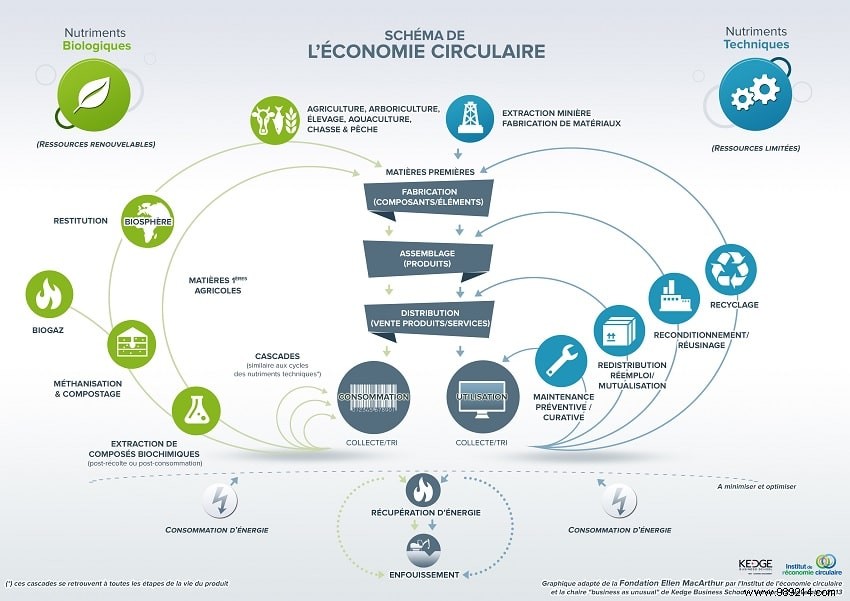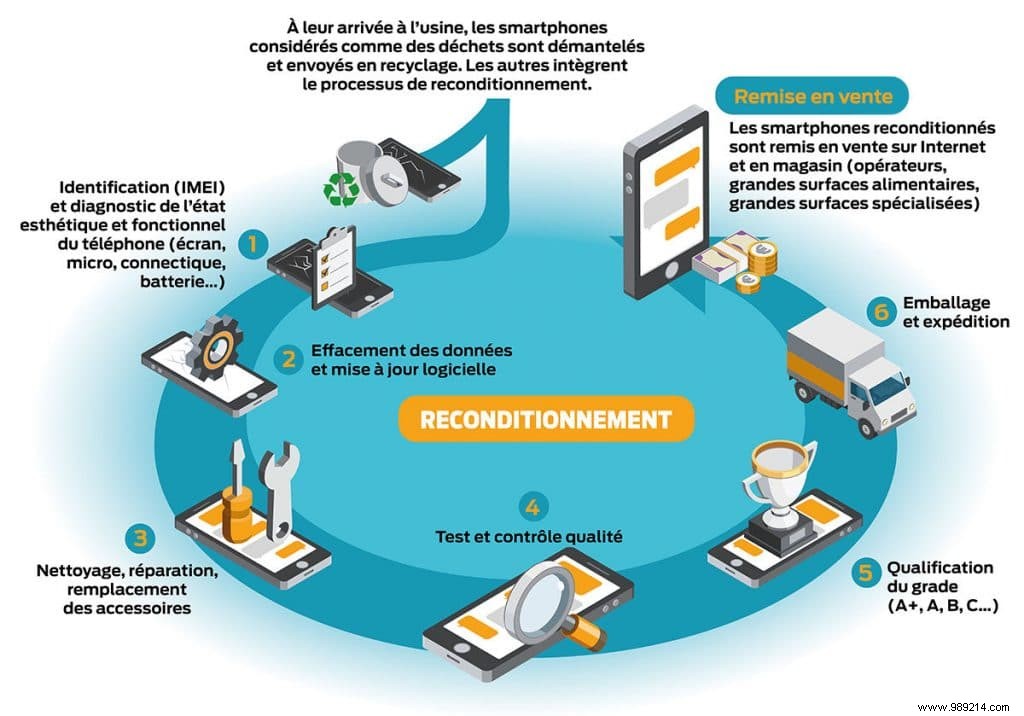Today, technological production has reached such a threshold that many objects are replaced daily by consumers and professionals. To promote eco-responsible behaviors such as recycling, the incorporation of reusable materials and renovation, regulators and companies have begun to develop new models for managing technological resources, including circular ecology and in particular reconditioning.
A circular economy is a systemic approach to economic development designed to benefit business, society and the environment. Unlike the linear “take-make-waste” model, a circular economy is regenerative by design and aims to gradually decouple growth from the consumption of finite resources. After defining what an economy really is, this learning path explores the nuances of the circular economy concept, including the difference between bio- and engineered materials, the different opportunities that exist to keep materials and products service, and the story of the idea.
Finally, the benefits of moving from a linear to a circular economy are notable. In a circular economy, economic activity strengthens and rebuilds the overall health of the system. The concept recognizes the importance of the economy working effectively at all scales – for large and small businesses, for organizations and individuals, globally and locally.
At the global level, the circular economy makes it possible to disconnect the growth of economic value from the consumption of raw materials and energy resources. Therefore, it generates fewer negative externalities and produces environmental benefits; At the local level, it makes it possible to relocate part of the production, offers new job opportunities and improves the trade balance.
As far as economic players are concerned, it is a source of many benefits for companies and consumers alike:for the first, it guarantees access to resources and protects against price volatility while creating new opportunities; for the latter, it makes it possible to switch from consumption based on use to consumption based on possession, thus giving access to innovative services at low prices.
The linear pattern of take, use, disposal is one of the main drivers of natural resource depletion, waste, environmental degradation and climate change. It has adverse effects on human health and significant global environmental benefits could be achieved, for example, by applying circular approaches to the production, use and disposal of plastics.

A circular economy promotes activities that preserve value in the form of energy, labor and materials. This means designing for sustainability, reusing, refurbishing and recycling to keep products, components and materials circulating in the economy. Circular systems make efficient use of bio-based materials by encouraging many different uses for them as they alternate between saving and natural systems.
The potential benefits of shifting to a circular economy extend beyond the economy and into the natural environment. By designing out waste and pollution, keeping products and materials in use, and regenerating rather than degrading natural systems, the circular economy makes a powerful contribution to achieving global climate goals.
As such, the AGIEC laws have brought many changes concerning circular ecology and its importance within product-creating companies. Thus, under the provisions of the AGIEC laws, companies will have to build their high-tech park in such a way that 20% of it comes from the circular economy.
Article L. 541-9-I of the Environmental Code provides that in order to achieve "the recycling objectives set by European Union law or law", the placing on the market of certain products and materials may "be subject to compliance with a minimum rate of incorporation of recycled material in these products and materials, with the exception of materials derived from renewable raw materials, provided that the analysis of the life cycle of this obligation is positive”.
According to a study, 28% of French people give a second life to their electronic devices through recycling. In contrast, many of these products are shelved and waiting; in fact, 19% of respondents say they keep them at home, even when they no longer use them. This habit is particularly significant among 18-24 year olds. And 31% of people over 55 say they recycle them. This study also reveals that 31% of French people have one day bought a refurbished electronic product, among which 43% are between 18 and 34 years old.

The circular economy, the ecological transition are gradually infusing mentalities. Especially the young and the most educated. Consumers increasingly have the reflex to give away or resell their old devices, rather than abandoning them or putting them in the cellar. According to the figures, 21% of consumers who bought a smartphone in the last year ended up reselling it, including 11% to phone or refurbishing companies.
The potential is much greater. The Environment and Energy Management Agency, Ademe, thus estimates that thirty million devices are stored in our drawers. Understanding the challenges of such a market, many companies are offering alternatives to the old worlds of consumption, which are aging and more polluting. Like Babarent, the new French player in refurbished smartphones, which is mainly aimed at companies, large express consumers of technological goods.
According to the standard definition, a refurbished smartphone is a device that has been used and disposed of at a collection point by its owner – and once the device has been examined and classified as fit for refurbishment, it is sent to a facility for reconditioning and is ultimately sold through an aftermarket channel.
The global refurbished market is estimated at more than 50 billion euros, of which 22 billion euros mainly concerns smartphones. A total of 140 million refurbished smartphones were sold in 2017 worldwide, an increase of 13% compared to 2016, according to figures from a study carried out by the market research company, Counterpoint Research, specializing in technology companies in the mobile sector.
In France, more than 2 million devices were sold last year, representing 10% of mobile phone sales in the country. A figure that has almost doubled in less than two years. But why such a boom? Faced with increasingly sophisticated, but at record high prices, smartphone devices, consumers are turning to less expensive alternatives, including phones, allowing for example to buy new and refurbished iPhone and Samsung models. In addition to being refurbished, mobiles can be rented, thus ensuring 100% use until the end of their life.
Unlike a second-hand product, it will be completely refurbished, with a much lower selling price. In addition, reconditioning reduces the ecological consequences of mobile phones by extending their lifespan. Over two years of existence, 85 to 95% of the CO2 emissions of a smartphone would be due to its production.
The IDC report, Global Forecast of Used Smartphones, 2019-2023, calculates that worldwide shipments of used smartphones, including officially refurbished and used smartphones, will reach a total of 206.7 million units in 2019, i.e. an annual growth of 17.6%. Study projects that used smartphone shipments will reach 332.9 million units by 2023, with a compound annual growth rate (CAGR) of 13.6% from 2018 to that year.